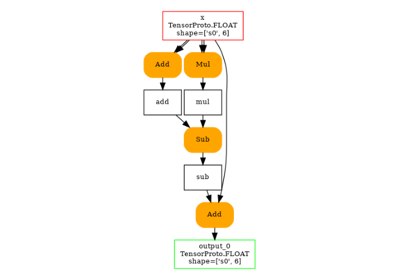Note
Go to the end to download the full example code.
to_onnx: Rename Dynamic Shapes¶
Example given in Use DYNAMIC or AUTO when dynamic shapes has constraints can only be exported
with dynamic shapes using torch.export.Dim.AUTO. As a result, the exported
onnx models have dynamic dimensions with unpredictable names.
Model with unpredictable names for dynamic shapes¶
import torch
from experimental_experiment.helpers import pretty_onnx
from experimental_experiment.torch_interpreter import to_onnx
class Model(torch.nn.Module):
def forward(self, x, y, z):
return torch.cat((x, y), axis=1) + z[:, ::2]
model = Model()
x = torch.randn(2, 3)
y = torch.randn(2, 5)
z = torch.randn(2, 16)
model(x, y, z)
tensor([[-1.1579, -0.3361, 3.3007, -0.9606, 0.3264, -1.0081, 0.3647, 0.7752],
[-1.1525, -0.7843, 1.4972, 0.2414, 0.4777, 1.0704, 1.6583, -0.8483]])
Let’s export it.
AUTO = torch.export.Dim.AUTO
ep = torch.export.export(
model,
(x, y, z),
dynamic_shapes=({0: AUTO, 1: AUTO}, {0: AUTO, 1: AUTO}, {0: AUTO, 1: AUTO}),
)
Let’s convert it into ONNX.
input: FLOAT[s35,s16] x
input: FLOAT[s58,s43] y
input: FLOAT[s7,s23] z
output: FLOAT[s35,s16+s43] output_0
Rename the dynamic shapes¶
We just need to give the onnx exporter the same information
torch.export.export() was given but we replace AUTO
by the name this dimension should have.
input: FLOAT[batch,dx] x
input: FLOAT[batch,dy] y
input: FLOAT[batch,dx+dy] z
output: FLOAT[batch,dx+dy] output_0
A model with an unknown output shape¶
class UnknownOutputModel(torch.nn.Module):
def forward(self, x):
return torch.nonzero(x)
model = UnknownOutputModel()
x = torch.randint(0, 2, (10, 2))
model(x)
tensor([[0, 0],
[1, 0],
[3, 0],
[4, 0],
[4, 1],
[6, 1],
[7, 0],
[8, 0],
[9, 0],
[9, 1]])
Let’s export it.
ep = torch.export.export(
model, (x,), dynamic_shapes=({0: torch.export.Dim("batch"), 1: AUTO},)
)
print(ep)
ExportedProgram:
class GraphModule(torch.nn.Module):
def forward(self, x: "i64[s35, s16]"):
# File: ~/github/experimental-experiment/_doc/recipes/plot_exporter_recipes_c_named_ds_auto.py:80 in forward, code: return torch.nonzero(x)
nonzero: "i64[u0, 2]" = torch.ops.aten.nonzero.default(x); x = None
#
sym_size_int_2: "Sym(u0)" = torch.ops.aten.sym_size.int(nonzero, 0)
sym_constrain_range_for_size_default = torch.ops.aten.sym_constrain_range_for_size.default(sym_size_int_2); sym_constrain_range_for_size_default = None
# File: ~/github/experimental-experiment/_doc/recipes/plot_exporter_recipes_c_named_ds_auto.py:80 in forward, code: return torch.nonzero(x)
ge: "Sym(u0 >= 0)" = sym_size_int_2 >= 0; sym_size_int_2 = None
_assert_scalar_default = torch.ops.aten._assert_scalar.default(ge, "Runtime assertion failed for expression u0 >= 0 on node 'ge'"); ge = _assert_scalar_default = None
return (nonzero,)
Graph signature:
# inputs
x: USER_INPUT
# outputs
nonzero: USER_OUTPUT
Range constraints: {u0: VR[0, 9223372036854775806], s35: VR[0, int_oo], s16: VR[2, int_oo]}
Let’s export it into ONNX.
input: INT64[batch,dx] x
output: INT64[NEWDIM_nonzero,2] output_0
The exporter has detected a dimension could not be infered from the input shape somewhere in the graph and introduced a new dimension name. Let’s rename it as well. Let’s also change the output name because the functionality may not be implemented yet when the output dynamic shapes are given as a tuple.
input: INT64[batch,dx] x
output: INT64[num_zeros,2] zeros
Total running time of the script: (0 minutes 11.275 seconds)
Related examples

Use DYNAMIC or AUTO when dynamic shapes has constraints



